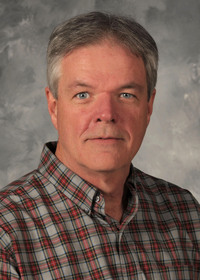Information Possibly Outdated
The information presented on this page was originally released on December 11, 2003. It may not be outdated, but please search our site for more current information. If you plan to quote or reference this information in a publication, please check with the Extension specialist or author before proceeding.
Agricultural economists tackle aquaculture risks
MISSISSIPPI STATE -- Keith Coble and Terry Hanson are listening a lot as part of their effort to reduce the economic risks associated with production of catfish and other aquaculture species.
Coble and Hanson, both agricultural economists with the Mississippi Agricultural and Forestry Experiment Station at Mississippi State University, are the principal investigators for the National Risk Management Feasability Program for Aquaculture, a four-year U.S. Department of Agriculture-funded partnership. They are working with USDA's Risk Management Agency and the Federal Crop Insurance Corp. to find ways to protect producers of the nation's top farm-raised aquaculture species from devastating economic losses.
As part of their work, they are listening to producers of catfish, salmon, trout and baitfish. U.S. producers of those species received more than $568 million for their products in 2001, the most recent year with complete sales data. Catfish accounted for 68 percent of the total.
"One of the biggest concerns among producers is disease," Coble said. "In fact, producers have told us that they worry about the impact yet-undiscovered diseases could have on their industry."
One way to provide economic protection for aquaculture would be a federal crop insurance program similar to those available for cotton and other row crops. The fact that no other livestock enterprise is covered by a government insurance program and the very nature of aquaculture make developing a plan difficult.
"Catfish and other aquaculture enterprises don't have the long-term production data available for row crops," Hanson said. "It's also difficult to determine fish numbers and pounds in the pond."
That's why Coble and Hanson are listening to producers, insurance experts, USDA personnel, industry leaders and aquatic disease experts in their quest for the best approach to providing insurance and other protective measures.
"Producers have told us that they don't want just normal losses covered," Coble said. "They already factor those losses into their operations. What they want and need is protection from catastrophic losses due to a disease outbreak or a natural disaster, such as flooding."
A benefit of a federal crop insurance program, Hanson added, is that USDA's Risk Management Agency will subsidize premiums, which will help address the cost issue.
"Producers tell us, however, that they don't want a program that will entice new producers with the idea that fish production is risk-free," he said.
As part of their research efforts, the economists are working with Carla Huston, an assistant professor at MSU's College of Veterinary Medicine. Huston organized an aquatic animal disease workshop for the project, which brought more than 30 scientists from across the nation to the Starkville campus to discuss health issues involving the projects's four species.
Over the course of the two-day workshop, participants discussed disease issues in aquaculture and their own research into many of the problems. On the second day, the scientists toured the National Warmwater Aquaculture Center in Stoneville and several commercial catfish operations in the Mississippi Delta.
One of the goals of the workshop was to stimulate ideas among the researchers for potential research projects that could be funded by the MSU program.
"Risk management is new to aquaculture and the workshop helped position Mississippi State as a leader in addressing health issues," Huston said. "Bringing together Mississippi State's veterinary medicine personnel with scientists who are working with species other than catfish was a way to look at some of our disease problems from different perspectives."
The workshop participants will be submitting reports to help provide guidelines for disease management.
Coble and Hanson are about halfway through the four-year project and will continue to gather input from agricultural insurance experts in this country and overseas.
Contact: Dr. Keith Coble, (662) 325-6670


